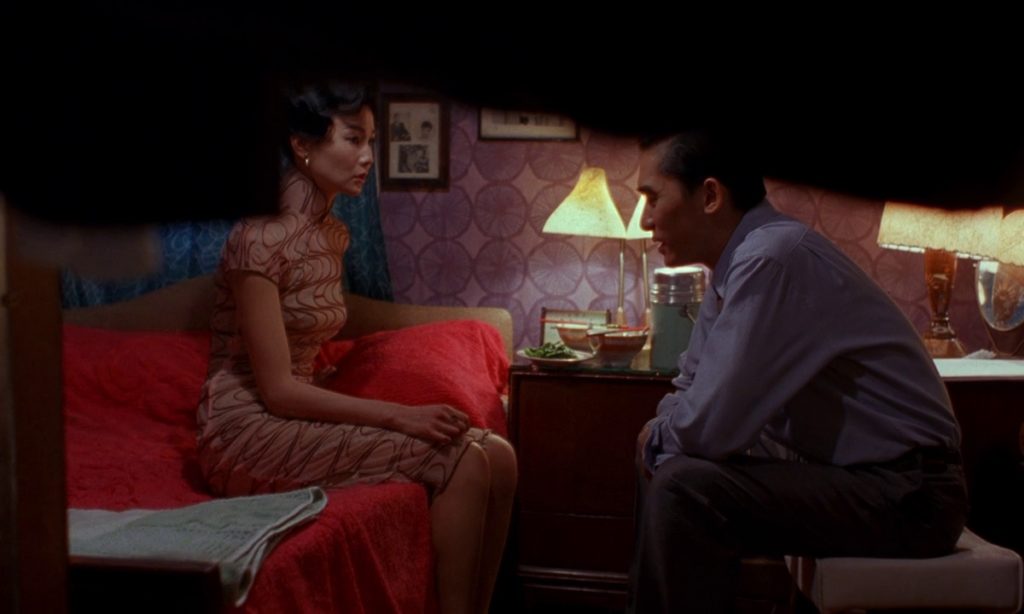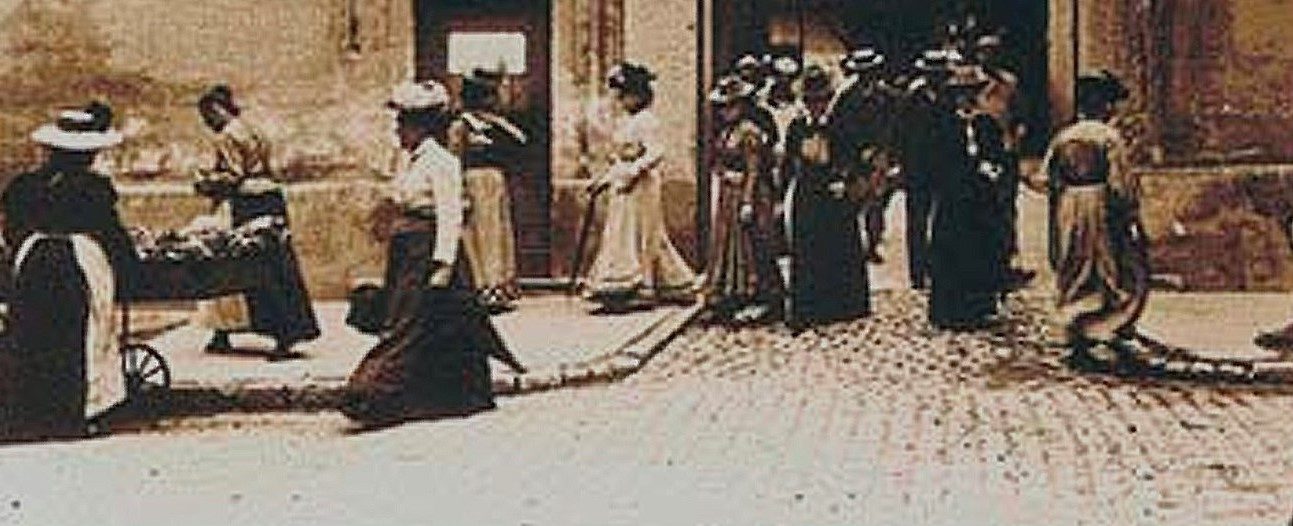Hong Kong, 2000
Directed by Wong Kar-wai
With Maggie Cheung (Mrs. Su), Tony Leung Chiu-wai (Mr. Chow)

This is a small, awkward world. It squeezes people in tiny places, stifles their sentiments, forces them to huddle tight and yet intimacy feels elusive. They struggle to carve up a space for themselves, but have to cope with whatever space society has designed for them. So they are shot walking endlessly through narrow streets, and even narrower back streets, and pacing around and biding their time more or less happily in fairly cramped apartments, surrounded by small objects that are not always theirs but still define their dull lives, stuff the camera likes to linger on. They easily bump against each other, they cannot ignore the presence of each other, and of the others.
This tightness extends to the routine of life: events they deal with are no bigger, no odder than the trivial worries and chores of the day and of course their occupations (the lead characters are often observed in their cramped workspace, answering a call, having a talk, typing, writing). Exiguity expressing mediocrity. Bold, unusual moves are barely imaginable in such a limited, restrained world.
This specific, visually mesmerizing aspect of the film reflects the housing difficulties the rising middle class in Hong Kong in the 1960s had to grapple with, a painful shortage of rooms which forced young couples to rent bedrooms in already occupied apartments, and striving to grasp the best opportunity before it was too late. This problem gives the film its starting point.
It opens with the mayhem caused by the funny fact that two couples move in the same story of the same building on the same day. The confusion enables Mrs. Su and Mr. Chow to meet for the first time, alone: their respective partners are not there, being so busy with their own work. Actually, they would so busy, those absent partners, that the audience is not going to see them often, and even when the camera captures them, it is just the back of a head, or a blurred silhouette, sometimes just the sound of their voices as they answer the queries of their neighbors.
The film is then the brisk, lively chronicle of lives standing side by side, but barely mixing. Courtesy and chance encounters are the only possibilities for Mrs. Su and Mr. Chow to get close, and perhaps to relieve them a little of their sad solitude: they can never spend enough time with their respective partners, Mrs. Chow working by night in a hotel and Mr. Su traveling to Japan for business.
When Mrs. Su and Mr. Chow start paying attention to simple but new fashion articles (namely neckties and handbags) they have noticed, even while the absence of their respective partners seem to straddle, and to last longer and longer, an unpleasant suspicion slowly rises. And as they talk over a restaurant meal, they end up realizing together than their partners have an affair on their own.
The unexpectedly shared sorrow brings Mrs. Su and Mr. Chow closer, they start chatting often, and they discover they share the same passion for the historical novels published in the daily newspapers. They make up their mind to write their own story while coming to terms with their unfortunate conjugal situations. They entertain the idea of living something together, but they give up on this fantasy. They used to say, they would never be lovers like their partners: ultimately that means they accept to let their fates part ways, and to stick to parts of their unsatisfactory lives, Mrs. Su becoming a mother, Mr. Chow moving from a position of reporter in a Hong Kong newspaper to a job of correspondent in a Singapore daily.
Both characters are confined to their small social circles, and they cannot frankly express their feelings. Social constraints put them under pressure, especially Mrs. Su, as she is a married woman, and consequently must rise to some decency and loyalty standards in a still socially conservative society. Landlord and folks stand ready to raise awkward questions. The small spaces where the two characters move reflect, embody those limitations – narrow does only describe a physical, spacial reality but also a state of mind, a narrow-minded society that is another aspect of the mediocrity of the 1960s Hong Kong.
But there is an exception, a telling one, a beautifully shot one, in this narrow world: this is the hotel where they work on their novel, with comfortable rooms and large corridors, an airy and magical place, with few people, a place where personal fantasy and emotion manage to prevail. For a brief moment, intimacy becomes possible, and gets even sustained, in an open space, funnily a very public space that is nevertheless out of reach for many inquisitive minds.
Mrs. Su and Mr. Chow are also prisoners of the relentless passage of time, with daily routines and moments of ennui, at home or at work. How can their relation evolve as days go by? It is hard to guess, as the audience is carried along the apparent monotony of their lives effortlessly, naturally. It does take a keen sense of observation to realize how time flies by, a month coming after another: it is in fact the regular change of the (splendid) cheongsams which Mrs. Su wears that hints at the flow of time. More remarkably, within this monotony the characters’ sentiments find a way to express themselves despite the pressure of the stultifying world the woman and the man belong to. Once again, only details tell the story: a hand put upon another, bodies slowly coming closer on the back seats of a taxi, for instance. The narration makes these sentiments’ evolution clear and touching thanks to an artful use of repetition. Behaviors are performed again and again: walking up and down the same street stairs, taking shelter under the same porch; but then a change appears: the two don’t look each other the same way and the words spoken aren’t quite the same, and how far their minds are changing becomes obvious. The score, composed by Shigeru Umebayashi, played over and over again, with its strings expressing sadness, underlines the pattern.
Camera favors close-ups and special effects are few. A rather linear montage keeps the focus on the characters’ evolution. Scenes are generally shot after dark, but what the romance is basking into a fantastic, delicate glow, the cinematography using a warm palette of yellow, ocher, brown, with the regular splash of red, a powerfully evocative glow suggesting fiery passion as well as sepia nostalgia. Director Wong Kar-wai has made here artistic choices which are starkly different from those shaping his previous feature, “Chun gwong cha sit – Happy Together” (1997), in order to illustrate and examine the emotion, pain, loneliness of the lead characters, a stream of dismal feelings that seems such a recurring, overriding theme for him. He demonstrates wonderfully he can imagine and craft fresh, fitting, and fantastic pictures and atmospheres to riff on this theme, barely repeating himself but offering the audience new precious moments and sentiments feeling spontaneous, vivid, and vibrant. The performances of the actors are a brilliant and moving study of self-control getting slowly eroded by deeper sentiments, as their characters’ restrained and demure behaviors struggle to keep under control the physical desire and the emotional loss they experience.
The final sequence of “Faa yeung nin wa – In The Mood For Love”, shot in another place, in a quite different cultural context, gives away all the poignancy of this story of a love that dared not to be fully acknowledged and shared, leaving instead regrets and more pain. Wistfulness is conveyed with stunning elegance and tact. This exploration of the ways intimacy can be brought to life against odds, stokes passion and hope, and then quietly put aside to let life go on, turns out to be a masterwork of restrained lyricism, upsetting and riveting.

